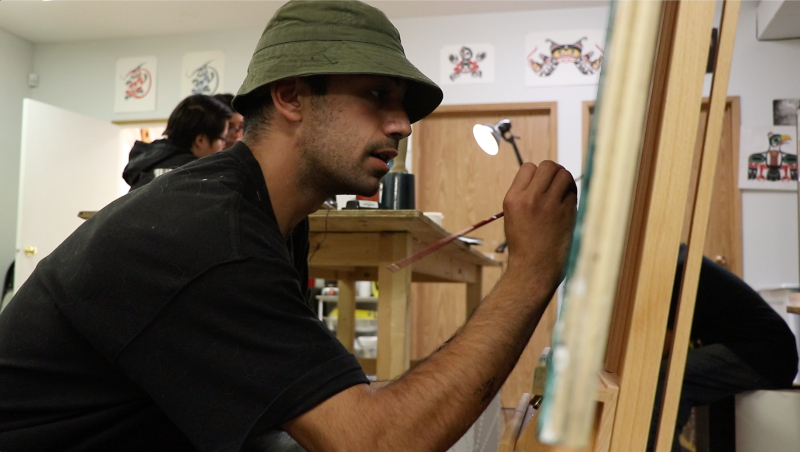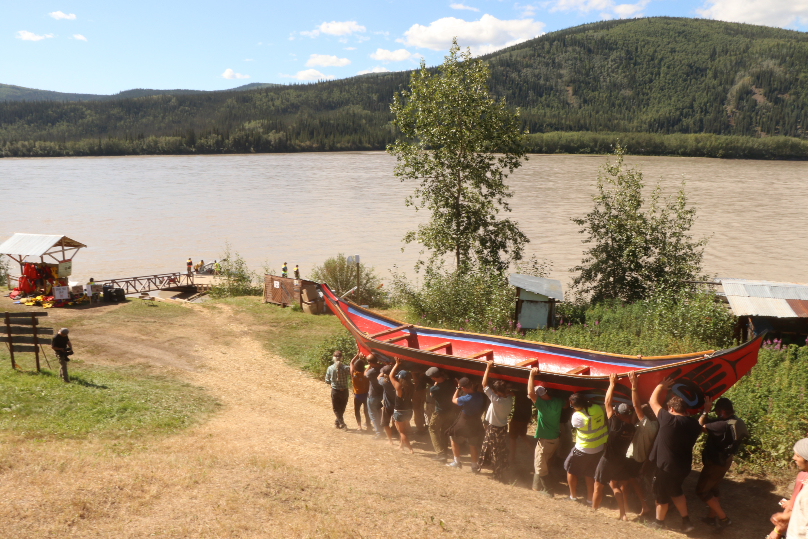Art as a community good
The Northern Cultural Expressions Society (NCES) is a meeting place of cultures that contribute to the artistic vitality of the territory. The executive director of NCES, Tanya Silverfox, has built up the organization to foster this mood – one where artists gather as a softer, but forceful, presence in society.
“I have visions of this place to make it what it could be,” Silverfox says. She wants to open it up to cultures beyond just First Nations, which is what the Society is associated with. “NCES – it doesn’t have a label just for one form of art.”
Silverfox says that she works specifically to forge a friendship with team members whether they work in administration or are artists. The strength of the partnership is built on family companionship, collaborative teamwork and strong lines of communication. It goes beyond painting styles and traditions.

The Northern Cultural Expressions Society is a cultural hub for Indigenous arts projects in Whitehorse, Yukon. It is open to Indigenous and non-Indigenous participation. [Photo © Jennifer Liu]
“I don’t see First Nations instructors really ever just limiting only specific to…one people. It’s so diverse in here that I find, I don’t think we would ever just aim towards one.”
Between each artist’s unique form line, style and method of carving, “I think it just combines itself,” Silverfox says. “It’s a big family – we don’t put labels on anything…If they bring a really good warm, positive energy with them, then they’re more than welcome to come in here and do their artwork.”
But NCES’s affairs hadn’t always been this cohesive. Under Silverfox, the NCES was able to balance a program of creative activities while getting their administration in order.
“It’s a lot of work,” the executive director admits. “It wasn’t very organized when I first started, so it’s been a really interesting two years, but it’s come a long way.”
NCES funding channels
The Northern Cultural Expressions Society is looking to extra funding sources to build upon their existing program offerings.
Expansion projects for traditional activities:
regalia-making, elder workshops at the Moosehide Gathering cultural celebration, traditional parenting partnership, parka-making
Community partnerships:
-Skookum Jim Friendship Centre for youth employment supports
-Yukon Government Health and Social Services for further employment and training
-Yukon Government Community Development Fund
-Canadian Museums Association for the Young Canada Works program
-Service Canada’s Horizon for Seniors has paid for elders’ fees at cultural workshops.
Silverfox says that NCES’s medium-term plans are backed by ongoing community support. Her plans for the society in the summer of 2019 include bringing in workshops on sewing, beading, and traditional regalia, and having elder craftspeople to lead the workshops. This is all pending funding, which she expects will follow with public interest.
“It’s actually really expensive, and sometimes it’s hard to find funding for stuff like that,”
NCES’s entire operations are funded through Yukon Government Tourism and Culture Branch, with the Society being their second-largest funded program. Silverfox lists NCES’s core operational costs: rent, utilities, staff wages, bookkeeping, equipment, materials and supplies, among other things.
“Everybody always could use more money,” Silverfox says. “It’s pretty amazing, so we are so grateful to have them fund us.” The Society is in the last year of a three-year agreement; in addition, they are in their second year of funding from Yukon Government Department of Education as well, which provides wages for carving educators and community outreach instructors. These channels have funded daw and parka-making workshops in the fall of 2018, and a paddle-making workshop in the spring of 2019. Thanks to these networks, elementary and high-school students learn how to carve, draw and put together art forms for the entire school year.
Silverfox had no prior background in arts and culture before stepping into her role. Previously, she was involved in the field of early child development. Now, working in a creative environment has allowed her to evaluate art differently from before. “I still haven’t drawn an ovoid – but these guys taught me a lot about art,” she says, laughing.
NCES’s extended engagement
Photos by Jennifer Liu

Ali Khoda (above) is highly engaged in the community: he has painted murals throughout Whitehorse, including to commemorate Missing and Murdered Indigenous Women (below). He is a realism instructor at NCES and was an exhibiting artist at Adäka Cultural festival last summer.


Under the guidance of master carvers, the NCES carvers crafted the totem pole at the end of Main Street (above) as well as the iconic dugout canoe that was used on a pilgrimage to Moosehide Gathering on the Yukon River (below).

Artist and former NCES carver Daniel Benjamin Gribben (below) says that Kevin Barr also played a key role, assisting with spiritual healing by giving counselling services for spiritual and mental well-being, hosting sweat lodges and showing carvers how to build willow huts for this purpose.

Tanya Silverfox…
On cultural sensitivity: “It’s the importance of teaching people traditions and art, and stories. [It’s] not the same as if mass-produced from another country…There’s an importance of teaching hands-on.”
On reconciliation: “I find that for true reconciliation, that it maybe not have it labelled either, but just to really work on…on fixing it. I don’t know how you would fix it though.”